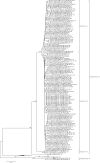Comprehensive surveillance data suggest a prominent role of parvovirus B19 infection in Belarus and the presence of a third subtype within subgenotype 1a
- PMID: 33441645
- PMCID: PMC7807032
- DOI: 10.1038/s41598-020-79587-2
Comprehensive surveillance data suggest a prominent role of parvovirus B19 infection in Belarus and the presence of a third subtype within subgenotype 1a
Abstract
Human parvovirus B19 (B19V) infection is not notifiable in Belarus and its most common clinical presentation erythema infectiosum (EI) is often difficult to distinguish from other exanthematous diseases. The objective of this study was to provide comprehensive data about EI epidemiology in Belarus based on the serological and molecular investigation of samples from measles and rubella discarded cases collected between 2005 and 2019. Overall, 4919 sera were investigated for IgM antibodies against B19V and the positive cases were analysed according to year, season and age. B19V DNA was amplified by PCR in a total of 238 sera from all over the country, and sequenced for phylogenetic analyses. B19V infection was confirmed in 1377 (27.8%) measles and rubella discarded cases. Two high incidence periods and a seasonal increase of EI between mid-February to mid-July were identified. Children from 4 to 6 and from 7 to 10 years of age represented the largest groups of patients (22.51% and 22.66% of all cases, respectively), followed by adults between 20 and 29 years of age (14.23%). Among the 238 B19Vs sequenced, one belonged to subgenotype 3b and 237 to subgenotype 1a with 81 (34.2%) clustering with subtypes 1a1 and 153 (64.6%) with 1a2. Three strains (1.2%) formed an additional, well-supported cluster suggesting the presence of another subtype of 1a, tentatively named 1a3. The epidemiological and molecular analyses highlighted not only the prominent role of B19V in exanthematous diseases in Belarus, but also suggested a previously underestimated diversity of subgenotype 1a sequences with a third subtype 1a3.
Conflict of interest statement
The authors declare no competing interests.
Figures







Similar articles
-
Prevalence and genotypic characterization of Human Parvovirus B19 in children with measles- and rubella-like illness in Iran.J Med Virol. 2016 Jun;88(6):947-53. doi: 10.1002/jmv.24425. Epub 2015 Nov 13. J Med Virol. 2016. PMID: 26538067
-
Human parvovirus B19 surveillance in patients with rash and fever from Belarus.J Med Virol. 2012 Jun;84(6):973-8. doi: 10.1002/jmv.23294. J Med Virol. 2012. PMID: 22499021
-
[Monitoring of implementation of international programs of poliomyelitis eradication and measles and rubella elimination in the Republic of Belarus].Zh Mikrobiol Epidemiol Immunobiol. 2012 Jan-Feb;(1):21-30. Zh Mikrobiol Epidemiol Immunobiol. 2012. PMID: 22442967 Russian.
-
Overall prevalence of human parvovirus B19 among blood donors in mainland China: A PRISMA-compliant meta-analysis.Medicine (Baltimore). 2020 Apr;99(17):e19832. doi: 10.1097/MD.0000000000019832. Medicine (Baltimore). 2020. PMID: 32332630 Free PMC article.
-
Update of the human parvovirus B19 biology.Transfus Clin Biol. 2016 Feb;23(1):5-12. doi: 10.1016/j.tracli.2015.11.006. Epub 2016 Jan 6. Transfus Clin Biol. 2016. PMID: 26778837 Review.
Cited by
-
Detection frequencies and viral load distribution of parvovirus B19 DNA in blood and plasma donations in England.Transfus Med. 2022 Oct;32(5):402-409. doi: 10.1111/tme.12893. Epub 2022 Jun 25. Transfus Med. 2022. PMID: 35751630 Free PMC article.
References
Publication types
MeSH terms
Substances
LinkOut - more resources
Full Text Sources
Other Literature Sources

